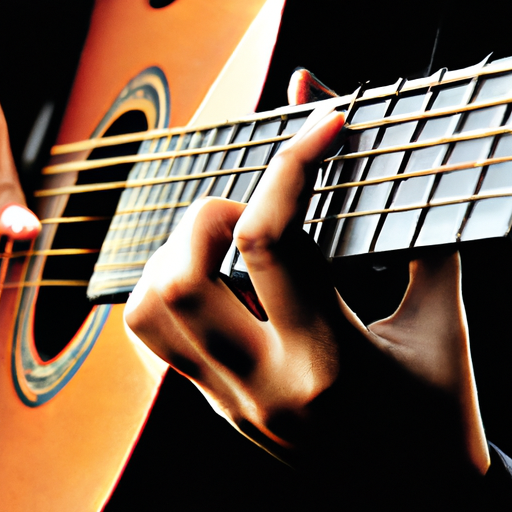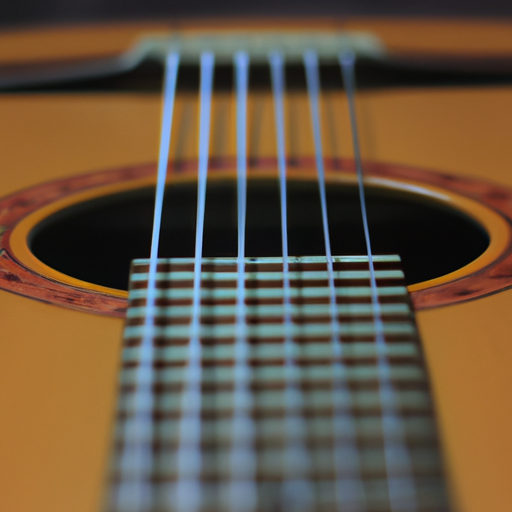
Playing the acoustic guitar is a rewarding and fulfilling hobby that can bring joy and entertainment to both the player and those around them. Whether you're a complete beginner or have some experience with other instruments, this step-by-step guide will help you get started on your acoustic guitar journey. From choosing the right guitar to learning chords and techniques, this article covers everything you need to know to become a proficient acoustic guitarist.

The acoustic guitar is a versatile instrument that can be used to play a wide range of musical genres, from folk and country to rock and pop. Before diving into the specifics of playing the guitar, it's important to understand the basics and benefits of learning to play this instrument.

Playing the acoustic guitar involves using your fingers to press down on the strings and strumming or plucking them to produce sound. It requires coordination between both hands and a good sense of rhythm. The guitar is typically played by strumming chords or fingerpicking individual strings.
Learning to play acoustic guitar offers numerous benefits, both for your mental and physical well-being. It can serve as a form of stress relief and creative expression. Playing the guitar can also improve your hand-eye coordination, finger dexterity, and overall cognitive abilities. Additionally, it provides an opportunity to connect with others through music and can even be a stepping stone to a career in music.
When starting your acoustic guitar journey, it's crucial to choose the right instrument that suits your needs and preferences. Here are some factors to consider when buying an acoustic guitar:
- Budget: Set a budget that you're comfortable with. Acoustic guitars can range in price from affordable to high-end.
- Body Type: Consider the body type that fits your playing style. Common body types include dreadnought, concert, and parlor.
- Wood Choice: Different wood types produce different tones. Popular options include spruce, mahogany, and rosewood.
- Playability: Ensure the guitar feels comfortable to play, with a suitable neck width and string action.
There are various types of acoustic guitars available, each with its own unique characteristics:
- Dreadnought: Known for its large body and bold sound, dreadnought guitars are versatile and suitable for various playing styles.
- Concert: Smaller in size compared to dreadnoughts, concert guitars are ideal for fingerstyle playing and individuals with smaller hands.
- Parlor: Parlor guitars have a compact size and vintage vibe. They produce a balanced and intimate sound.
- Jumbo: Jumbo guitars offer a booming, bass-heavy sound. They're popular among players who require a strong presence in their sound.
Before you can start playing, it's important to tune your acoustic guitar properly. Tuning ensures that your guitar produces accurate and pleasant-sounding notes. Here's why tuning is crucial and some methods for tuning your guitar:
A properly tuned guitar ensures that you're playing the correct notes and chords. It also trains your ear to recognize different pitches and helps develop your musical ear. Tuning is essential for playing in tune with other instruments or when playing along with recorded music.
- Electronic Tuner: An electronic tuner is a reliable and convenient tool for tuning your guitar. It detects the pitch of each string and provides visual feedback to help you tune accurately.
- Piano: If you have access to a piano or keyboard, you can use it as a reference to tune your guitar. Each string corresponds to a specific note on the piano.
- Online Tuners: There are various online guitar tuners available that play reference tones for each string, allowing you to match the pitch of your guitar strings.
- Smartphone Apps: There are also smartphone apps specifically designed for guitar tuning. These apps use the device's microphone to detect the pitch and provide tuning guidance.
Chords are the building blocks of music and are essential for playing songs on the acoustic guitar. Here are some of the most essential chords for beginners:
- E Major: This chord is played by placing your index finger on the 1st fret of the 3rd string, middle finger on the 2nd fret of the 5th string, and ring finger on the 2nd fret of the 4th string.
- A Major: To play this chord, place your index finger on the 1st fret of the 4th string and middle finger on the 2nd fret of the 3rd string.
- D Major: This chord is played by placing your index finger on the 2nd fret of the 3rd string, ring finger on the 3rd fret of the 2nd string, and middle finger on the 2nd fret of the 1st string.
- G Major: To play this chord, place your index finger on the 2nd fret of the 5th string, middle finger on the 3rd fret of the 6th string, and ring finger on the 3rd fret of the 1st string.
- C Major: This chord is played by placing your index finger on the 1st fret of the 2nd string, middle finger on the 2nd fret of the 4th string, and ring finger on the 3rd fret of the 5th string.
To play a chord, position your fingers on the appropriate frets and strings as indicated in the chord diagram. Press down on the strings firmly enough to produce a clear sound but avoid pressing too hard, as it can cause the strings to buzz. Strum the strings with your other hand using a pick or your thumb, ensuring that all the notes in the chord ring out clearly.
Once you've learned some basic chords, it's time to incorporate strumming patterns to add rhythm and groove to your playing. Here's how to strum with rhythm and some different strumming patterns:
Strumming with rhythm involves understanding and maintaining a steady beat while strumming the guitar strings. It's important to count and feel the rhythm as you strum. Start by practicing simple strumming patterns with just downstrokes and gradually progress to more complex patterns that incorporate upstrokes.
- Downstrokes Only: This is the simplest strumming pattern, where you strum down on each beat. It's commonly used in folk and country music.
- Upstrokes Only: In this pattern, you strum up on each beat. It creates a lighter and more upbeat sound and is often used in reggae and ska music.
- Down-Up Strumming: This pattern involves strumming down on the downbeat and up on the upbeat. It adds more dynamics and groove to your playing.
- Syncopated Strumming: Syncopated strumming patterns emphasize off-beats and create a rhythmic tension. They are commonly used in blues, jazz, and funk music.
Fingerpicking is a technique that allows you to play melodies, arpeggios, and bass lines simultaneously on the acoustic guitar. Here's an introduction to fingerpicking and some different fingerpicking techniques:
Fingerpicking involves using your thumb, index, middle, and ring fingers to pluck the strings of the guitar. Each finger is assigned to a specific string, and the thumb is primarily responsible for plucking the bass notes. Fingerpicking allows for more intricate and complex playing compared to strumming.
- Travis Picking: Travis picking is a popular fingerpicking technique that involves alternating the thumb between two or three bass strings while plucking the higher strings with the fingers. It's commonly used in folk, country, and blues music.
- Classical Fingerpicking: This technique is often used in classical guitar music and involves using all fingers to pluck individual strings to create melodic lines and harmonies.
- Clawhammer Fingerpicking: Clawhammer fingerpicking is a technique commonly used in folk and old-time music. It involves using the thumb to strike the bass strings while the index or middle finger brushes the higher strings.
- Fingerstyle Blues: Fingerstyle blues involves a combination of alternating bass notes and melody lines played with the fingers. It's commonly used in blues and ragtime music.
One of the most exciting parts of learning to play the acoustic guitar is being able to play songs. Here are some easy songs for beginners and some tips for learning to play songs:
- "Knockin' on Heaven's Door" by Bob Dylan
- "Wonderwall" by Oasis
- "Horse with No Name" by America
- "You're Beautiful" by James Blunt
- "Stand By Me" by Ben E. King
- Start with simple songs that use basic chords and strumming patterns.
- Practice playing along with the original recordings to improve your sense of timing and rhythm.
- Break down the song into smaller sections and practice each section individually before playing the entire song.
- Use online resources, such as guitar tabs or chord charts, to help you learn the song more easily.
To become a proficient acoustic guitarist, it's important to continually work on improving your technique. Here are some tips on how to practice effectively and common mistakes to avoid:
- Set specific goals for each practice session, such as learning a new chord or improving your strumming technique.
- Break down complex techniques into smaller, manageable exercises and practice them slowly and accurately before increasing the tempo.
- Practice regularly and consistently, even if it's just for a short period of time each day. Short, focused practice sessions are often more effective than long, unfocused ones.
- Pressing too hard on the strings, which can cause pain and affect your playing accuracy.
- Neglecting proper hand and finger positioning, which can lead to inefficient playing technique and hinder your progress.
- Rushing through exercises or songs without paying attention to precision and timing.
- Not using a metronome or backing tracks to practice playing in time with a steady beat.
Once you've become comfortable with basic chords and techniques, you can move on to more complex chords and advanced techniques to further enhance your playing. Here are some examples:
- Barre Chords: Barre chords involve using your index finger to press down multiple strings on a single fret, effectively creating a "bar." They allow you to play chords in different positions and keys.
- Extended Chords: Extended chords, such as major 7th, minor 7th, and dominant 7th, add additional tones to basic chords and create a richer and more sophisticated sound.
- Suspended Chords: Suspended chords, like sus2 and sus4, add tension and a unique flavor to your playing. They are commonly used in pop and rock music.
- Hammer-ons and Pull-offs: Hammer-ons and pull-offs are techniques used to create smooth transitions between notes. They involve using your fretting hand to add or remove fingers without picking the strings.
- Slides: Slides involve moving from one note to another by smoothly gliding your finger along the fretboard. They add a smooth and expressive sound to your playing.
- Fingerpicking Patterns: Once you've mastered basic fingerpicking, you can explore more complex fingerpicking patterns that involve simultaneous bass lines, melody, and harmony.
In conclusion, learning to play the acoustic guitar is a rewarding journey that offers countless benefits. It allows you to express your creativity, relieves stress, and provides a means of connecting with others through music. By following this step-by-step guide, you'll be well on your way to becoming a proficient acoustic guitarist. Remember to practice regularly, be patient with yourself, and most importantly, enjoy the process of making music with your acoustic guitar!